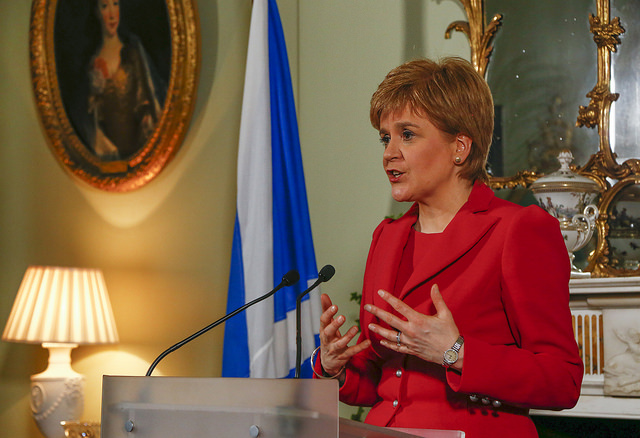The gauntlet is down.
To the surprise of many Nicola Sturgeon announced today that she will seek a second referendum on Scottish independence to be held between autumn 2018 and spring 2019. She is set to ask the Scottish Parliament for permission to do so next, yet given that there is a majority of pro-independence MSPs (the SNP and the Greens), this part should be pretty straightforward. The first hurdle will come from the UK Government which will have to approve the Scottish first minister’s request for a section 30 order transferring temporary powers to Holyrood to hold a referendum. Legally, Prime Minister Theresa May could refuse to grant legal permission to hold a referendum, but I think this looks unlikely. Jeremy Corbyn has also confirmed that the Labour Party would not block such a request.
What is likely, however, is that the Prime Minister will play hard ball on the issue, particularly over timing. In the previous independence referendum, the then First Minister Alex Salmond, was given considerable freedom to choose a referendum date. However, this time around negotiations will not be so simple. There will be further deliberations on the question(s), the franchise (will 16-17 year olds be allowed to vote as was the case in 2014?), and the timing. It may well be that Theresa May’s agreement to another referendum will hinge on the last issue, given under condition that that it is not held until Brexit negotiations are over. The issue now is not whether there will be another referendum, but when.
Calling the referendum is, as I have argued previously, potentially the most important decision of Nicola Sturgeon’s premiership. She made it clear this morning that calling for a referendum is a result of the British government’s refusal to move ‘even an inch in pursuit of compromise and agreement’. With speculation that Article 50 will be triggered in the coming days, the Scottish First Minister’s pre-emptive strike may make the British Government think again on some of its negotiating positions. I find it unlikely, however, that Scotland will be given a special deal in the Brexit negotiations.
Theresa May has hitherto avoided saying whether she will grant or block the Scottish government’s request. It is a given that she will campaign for a ‘No’ to independence vote. Nevertheless, Brexit indisputably has introduced a new and challenging dynamic to the independence debate that both sides will need to contend with in a future referendum campaign. For the unionists, Sturgeon’s bold move today will be seen as reckless and opportunist, an attempt to further complicate the Brexit negotiations and strengthen the case for independence. This is exemplified by Theresa May’s official spokesperson noting that ‘another referendum would be divisive and cause huge economic uncertainty at the worst possible time’. For pro-independence supporters, however, independence is painted as an alternative to the potential economic uncertainty of Brexit. The Scottish voters, they argue, must have a choice: Hard Brexit Britain or an Independent Scotland.
It seems the future of Scotland is destined to be outside one (if not both) of the unions of which it is currently a member. Support for independence has not dramatically risen since either the 2014 independence referendum or the 2016 Brexit referendum and while it is currently around the 50%, it has yet to remain steady above this threshold. It remains to be seen how the impending Brexit negotiations will influence the independence issue, but a hard Brexit or indeed the prospect of no deal at the end of the negotiations have merely fuelled and emboldened SNP demands for another referendum. It is a bold move for Sturgeon. She will either go down in history as the first minister who presided over the independence of Scotland, or the leader who got it spectacularly wrong.
Let the games begin!
 Paul Anderson is a PhD researcher at Canterbury Christ Church University. His main research focuses on territorial autonomy and secessionist movements in western plurinational democracies.
Paul Anderson is a PhD researcher at Canterbury Christ Church University. His main research focuses on territorial autonomy and secessionist movements in western plurinational democracies.
An extended version of this blog post appeared on the LSE EUROPP Blog on 14 March 2017.
 Politics
Politics Anna Vanaga
Anna Vanaga 772
772


